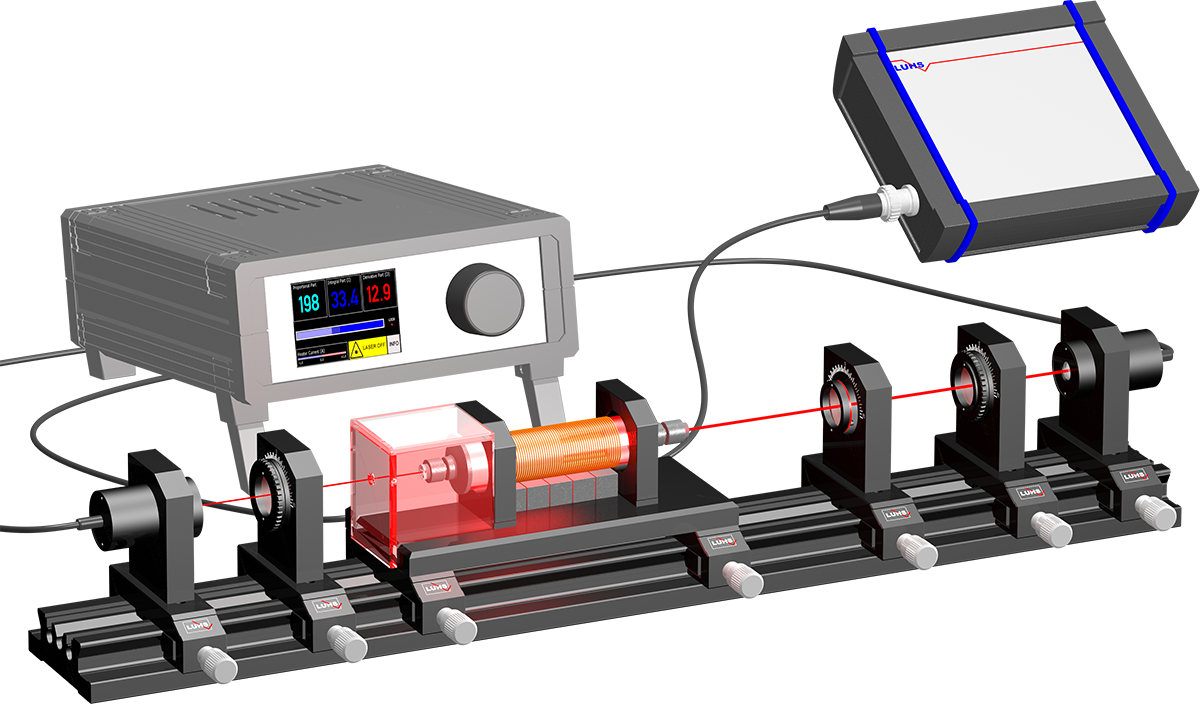Single Mode HeNe-Laser
Doppler Gain Profile
Frequency Pulling
Beat Frequency
PID - Controller
Quarter and half wave plate
Longitudinal Zeeman Effect
Circular Laser Polarization
LM-0200 Zeeman Laser Frequency Stabilization
Topics:

LM-0200 Zeeman Laser Frequency Stabilization
In principle the frequency of a laser is defined by its own intrinsic parameters. However in reality the emission frequency f is not stable within a couple of hours. For high precision interferometric length measurements at least a long term stability of df/f ≤ 10-8 must be provided within 8 hours. To obtain such a performance a stabilization loop must be added to the Laser. Within this setup the Zeeman stabilization - the most commonly used technique - of a HeNe-Laser is applied and demonstrated. The length of the HeNe laser tube is chosen in such a way that only a single mode can oscillate.A longitudinal magnetic field is applied to the HeNe tube and the normal linearly polarized splits into two oppositely circular polarized modes due to the Zeeman effect. One can observe the difference or beat frequency with a photodetector behind a polarizer. The beat frequency becomes minimum, when the HeNe laser tube (cavity) is aligned to the center of the gain profile. The control loop consists of the beat frequency detection and an embedded micro processor based PID - controller. The active actuator is formed by a bifilar heater coil surrounding the laser tube. The task of the students is to understand the stabilization concept and the underlying control technique of a PID controller. The PID parameter can be set independently from each other and the student will recognize the influence of this parameter on the control loop. The provided software records and displays the controller as well as laser response allowing to record a Bode diagram or the beat frequency drift of the free running laser.
| Item | Code | Qty. | Description |
|---|---|---|---|
| 1 | DC-0064 | 1 | High voltage supply 6.5 mA |
| 2 | DC-0120 | 2 | Si-PIN Photodetector, BPX61 |
| 3 | DC-0310 | 1 | Laser frequency stabilizer |
| 4 | DC-0380 | 1 | Photodetector Junction Box ZB1 |
| 5 | MM-0020 | 2 | Mounting plate C25 on carrier MG20 |
| 6 | MP-0150 | 1 | Optical Bench MG-65, 500 mm |
| 7 | OM-0400 | 2 | Rotary Polarizer / Analyser 360° on Carrier 20 mm |
| 8 | OM-0410 | 1 | Rotary quarter wave plate on carrier |
| 9 | OM-0910 | 1 | Single Mode HeNe laser with Zeeman magnet |
| 10 | UM-LM02 | 1 | Manual Laser frequency stabilization |
| Required Option (order separately) | |||
| 11 | CA-0120 | 1 | Tablet PC Windows |
| 12 | CA-0200 | 1 | Oscilloscope 100 MHz digital, two channel |
| 13 | ES-0300 | 1 | PID Controller Software |
| Media Type | Title | File Size [MBytes] | Action |
|---|---|---|---|
| LM-0200 Zeeman Laser Frequency Stabilization Currently under Revision |
6.93 MB | Download | |
| Catalogue Page | |||
| JPEG, PNG, SVG | Pictures | ||
| MP4 | Video |